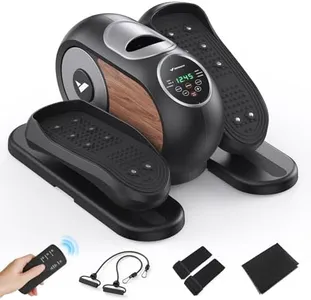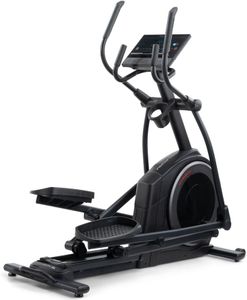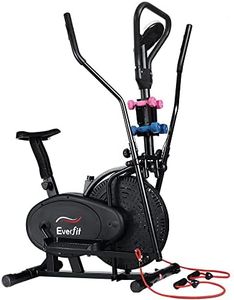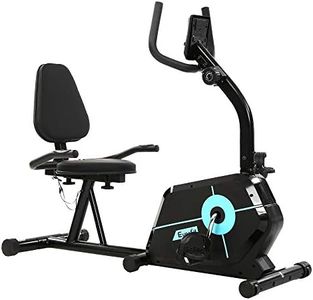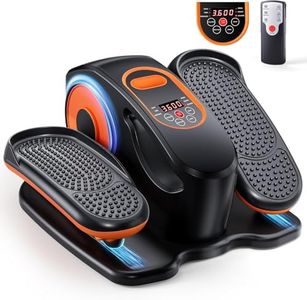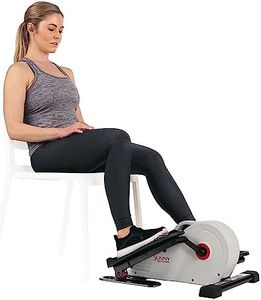We Use CookiesWe use cookies to enhance the security, performance,
functionality and for analytical and promotional activities. By continuing to browse this site you
are agreeing to our privacy policy
10 Best Elliptical Cross Trainer
From leading brands and best sellers available on the web.Buying Guide for the Best Elliptical Cross Trainer
Choosing an elliptical cross trainer is all about matching the features to your fitness goals, comfort, and available space. As you consider different models, focus on the trainer’s design, resistance systems, stride length, and the overall user experience. It’s essential to understand the key specs, as they directly affect how the machine feels and how well it will fit into your routine. Whether you’re a beginner or an advanced user, a bit of knowledge about the specifications will help you find a machine that will keep you motivated and safe while working out.Stride LengthStride length is the distance your feet move from front to back during the elliptical motion. This spec is important because it affects how natural and comfortable your workout feels. Short stride lengths (about 14 to 16 inches) suit shorter users or those with limited space and provide a compact workout, but may feel cramped for taller people. Standard strides (18 to 20 inches) offer a more natural movement for most adults, making them the most common choice. If you are taller or want a longer, running-like stride, look for trainers with stride lengths around 20 to 22 inches. Consider your own height, leg length, and whether multiple users of different heights will share the machine.
Resistance LevelsResistance levels refer to how much effort you must use to push against the pedals. Higher resistance levels allow you to make your workouts more challenging. Machines with fewer levels (8–12) can be limiting for those who want variety or significant improvement over time. If you want the ability to start easy and gradually take on more intense sessions, look for at least 16–20 resistance levels. Think about your current fitness level and whether you want room to grow your strength or if you just want a basic, steady workout.
Flywheel WeightThe flywheel is the part inside the elliptical that creates momentum and smoothness as you pedal. Its weight affects how fluid and stable the motion feels. Light flywheels (under 10 lbs) can feel choppy, especially if you want a steady or quiet experience. Medium to heavy flywheels (14 to 20+ lbs) give a smoother, more gym-like feel and add stability. If you plan on frequent or high-intensity use, opt for a heavier flywheel for better performance. If portability or compactness matters most, lighter flywheels can be considered but may offer less smoothness.
Incline AdjustmentIncline adjustment allows you to change the angle of your stride, simulating uphill motion. This spec is important for adding workout variety and targeting different muscle groups, especially your glutes and thighs. Some ellipticals have manual incline (changed by getting off and adjusting), while more advanced ones offer electronic incline (changeable at the touch of a button during your workout). If you enjoy challenging workouts or want more versatility, look for a machine with electronic incline adjustment. If you’re new to exercise or mainly want gentle cardio, you might not need this feature.
Console FeaturesThe console is the display where you see time, speed, distance, heart rate, and other metrics. More advanced consoles may have built-in workout programs, Bluetooth connectivity, speakers, and interactive options. For users who like guidance, tracking progress, or entertainment (like music or fitness apps), a more feature-rich console is a good choice. For those who prefer simplicity or mainly want to watch TV while exercising, a basic display is sufficient. Reflect on how much you’ll use workout data and technology when deciding on console features.
User Weight CapacityThis spec tells you the maximum weight the elliptical can safely support. It’s important for safe and long-lasting use. Lower capacity machines (220–250 lbs) may work for some, but if durability or multiple users are important, aim for higher capacities (300 lbs and above). Always choose a model with a capacity at least 20–30 lbs over your own weight to ensure stability and durability, especially if you’re using the machine frequently.
Foot Pedal AdjustabilityFoot pedal adjustability means you can change the angle, spacing, or cushioning of the pedals for extra comfort. This spec matters if you have joint sensitivity, foot issues, or want to reduce fatigue during long workouts. Some machines let you adjust pedal tilt or add cushioning, making them more comfortable for users with specific needs. If comfort is a top concern, look for adjustable or cushioned pedals. If you don’t have particular comfort needs, standard pedals will usually suffice.
Size and StorageThe size of the elliptical affects where you can place it and whether it’s easy to store away. More compact models fit small spaces better and may have wheels or folding capabilities. Larger models often offer a more stable, gym-like experience but require more room. Before purchasing, measure your available space and consider if you’ll need to move or store the machine often. Match the size to your home setup and storage needs.
